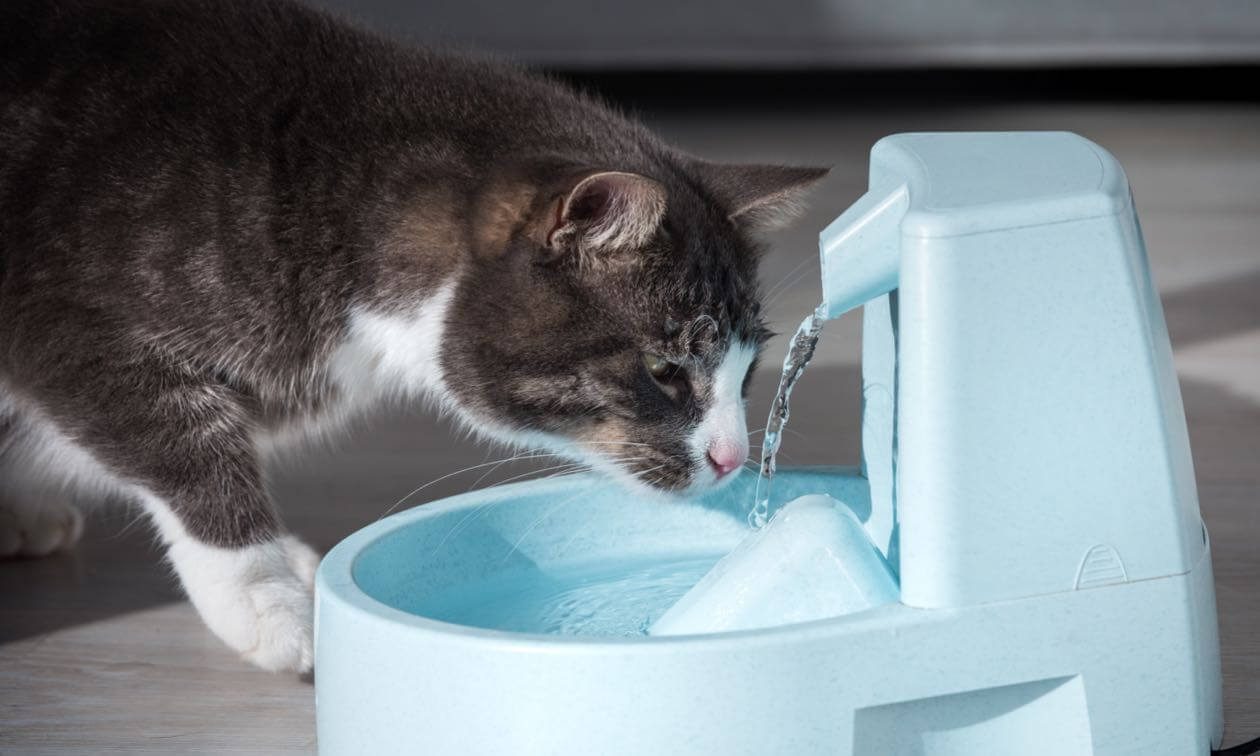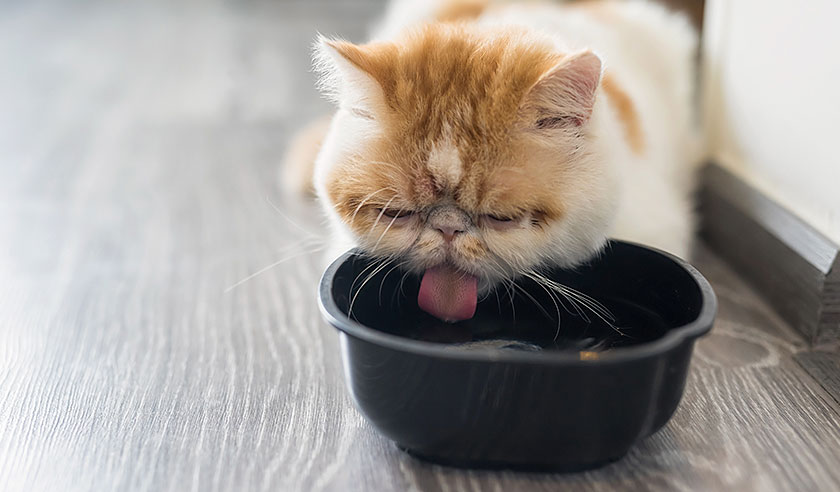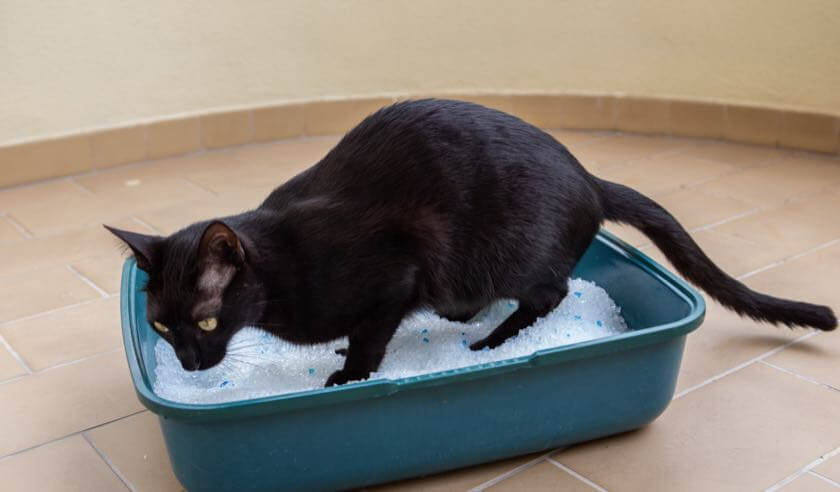Do you worry about your cat drinking enough water? There are certain diseases your cat can get that may make it very important to get a cat to drink more water. Here's how to get your cat to drink more water.
Why Drinking Water Is Important for Cats
A cat's body is made up of 60%-70% water1. Therefore, consuming ample water is critical to their survival and health.
Water plays a vital role in many functions of your cat's body — it affects organ function, temperature regulation, joint lubrication, nutrient transportation and absorption, circulation, detoxification, and digestion. When cats are not properly hydrated, their body can't perform these functions efficiently
Monitoring your cat's water consumption routinely is important. Dehydration (when your cat uses or loses more fluids than they take in) creates an imbalance of water and electrolytes in the body. And it can happen quickly and lead to medical problems, such as feline lower urinary tract disease, poor skin health, and more.
Additionally, cats with certain medical conditions, such as chronic kidney diseases, diabetes, vomiting, and diarrhea, are at an increased risk of dehydration and further complications.
Ways to Get Your Cat to Drink More Water
How much your cat needs to drink depends on their size, health, age, diet, and activity level. Cats need to consume about 4 ounces of water per five pounds of lean body weight per day, so the average 10-pound cat should drink about one cup of water per day2. Hopefully, one or more of these options will help increase your cat's water intake and help them maintain proper hydration.
- Choose the Right Bowl
You may have to try various bowl types (glass, ceramic, or stainless steel) to determine what your cat prefers. It's recommended to avoid plastic bowls since they can harbor bacteria in scratches or other imperfections that can lead to digestive issues or cat chin acne. Cats prefer shallow bowls so they can drink without putting their head down in the bowl. Wide bowls are best, so their whiskers don't touch the edges (this also helps prevent the bowl from being knocked over). - Choose the Right Location
Place several water bowls around the home. Find quiet locations where your cat can drink undisturbed. Avoid placing bowls near frequently used doors or in heavy traffic areas (and make sure they have more than one way to get to and walk away from the bowl). Cats prefer not to have water (or food) bowls near litter boxes. - Keep it Clean
Cats have a keen sense of smell, so cleaning their water bowls daily is essential to prevent unpleasant smells and bacteria buildup. - Keep it Fresh
Water should be changed daily. - Fill it to the Brim
Most cats prefer to drink from full water bowls. - Change the Source
Some cats dislike tap water due to its taste and smell. You can try filtered or bottled water. You can even purchase specialized water designed for cats, which has no minerals and is pH optimized. - Try Different Temperatures
Some cats prefer it warm (especially in the winter) while others like room temperature or cool water. Adding a couple of ice cubes can cool water down and often fascinate and encourage cats to drink as they bob around in the bowl. - Add Some Flavor
Add water from a can of tuna (packed in spring water, not oil) to your cat's water bowl. Start with about ¼ teaspoon per bowl. For the average-sized cat bowl, you can gradually increase the amount to no more than a teaspoon per day. Low-sodium chicken broth (with no onions or garlic) is another flavoring option. Don’t let the water sit out all day with any of these. Just like you wouldn't eat tuna that had been on the counter for a few hours, it's probably not great for your cat either. - Use a Fountain
In the wild, cats often prefer to drink running water from a stream or brook over stagnant water from a puddle. Fountains replicate this. It's important to keep fountains clean. Some are dishwasher safe, and for others, you can use small brushes to clean the spout and motor regularly. If the fountain has a filter, change it per the manufacturer's guidelines. Adding flavoring to water fountains is not recommended. - Try Non-water Sources of Hydration
Water isn't the only way for cats to get hydrated. Adding canned food to your cat’s diet is one of the best ways to increase a cat’s water intake. Adding or gradually switching canned food (75% to 80% water) can help increase your cat's water intake. Even just adding warm water or low-sodium chicken broth (no onion or garlic) to dry food can help. It’s important to realize that cats that eat wet food may drink less, and cats that eat dry food usually take more of their daily water requirement in by drinking.
Signs of Dehydration in Cats
Recognizing the signs of dehydration is important. They include:
- Lethargy
- Depression
- Lack of Appetite
- Dry, Tacky Gums and Mouth
- Sunken Eyes
- Elevated Heart Rate
- Decreased Skin Elasticity
You can do the "skin tent test" to help gauge your cat's hydration level. Gently lift the skin over the shoulder blades upward. If your cat is well hydrated, the skin will snap back to cover the shoulder blades. If they're dehydrated, the skin will not return to its normal position quickly.
Call your veterinarian if you notice any of these signs. It's critical to determine the underlying cause of the dehydration and address it promptly.
ZPC-02506
- DiBartola S, Wellman M, Kohn C. Applied physiology of body fluids. In: DiBartola S, ed. Fluid, Electrolyte and Acid-Base Disorders in Small Animal Practice, 3rd ed. (St. Louis, MO: Saunders Elsevier); 2006:3-26.
- Hydration. (2021, July 8). Cornell University College of Veterinary Medicine. https://www.vet.cornell.edu/departments-centers-and-institutes/cornell-feline-health-center/health-information/feline-health-topics/hydration. Accessed February 9, 2023.





